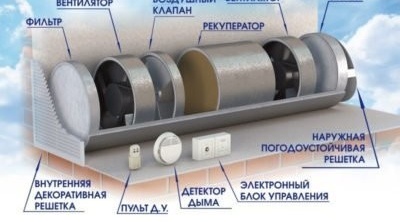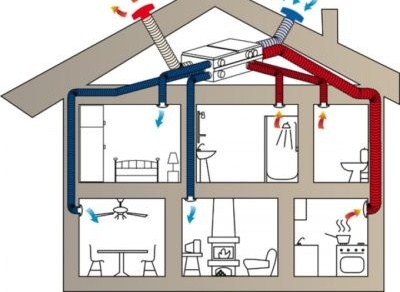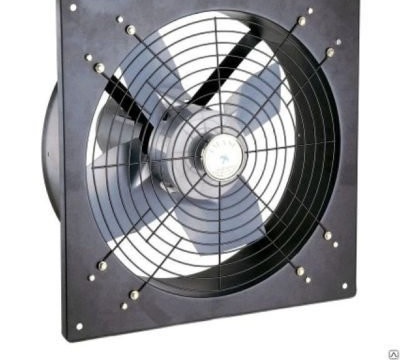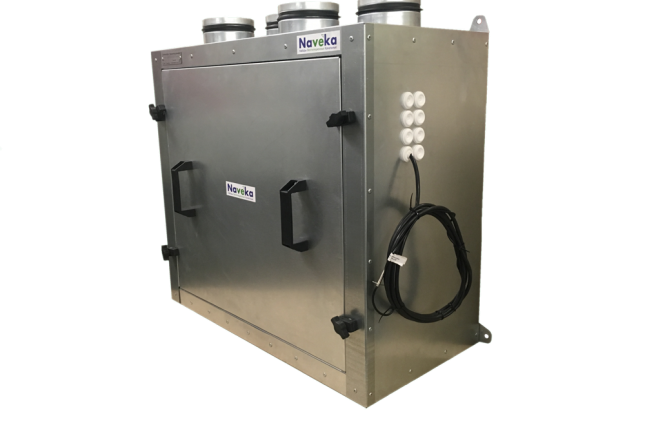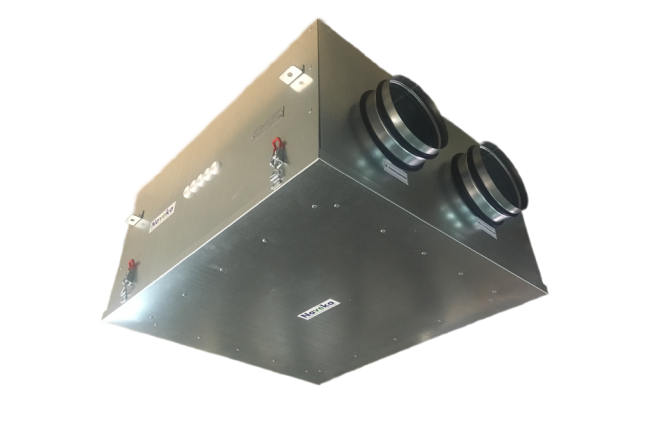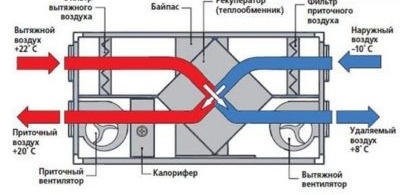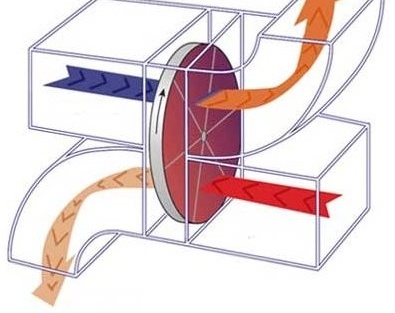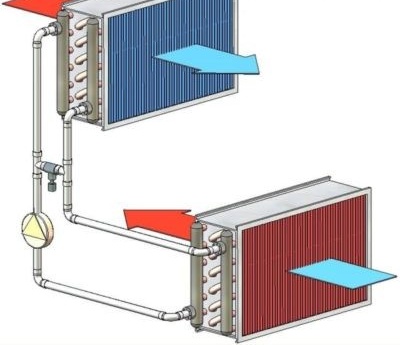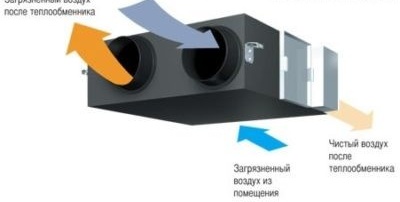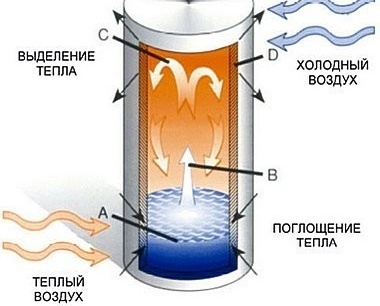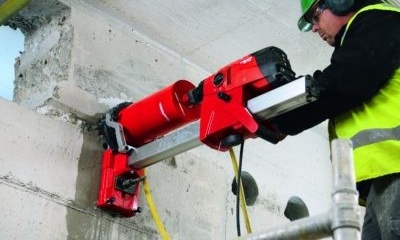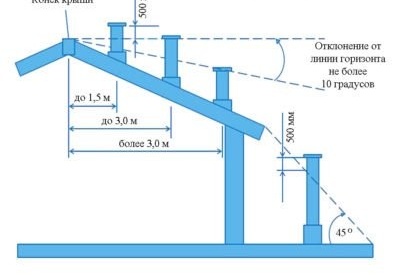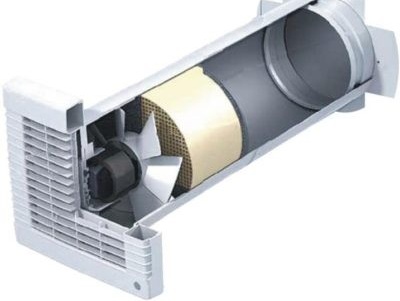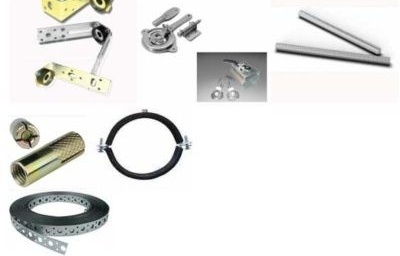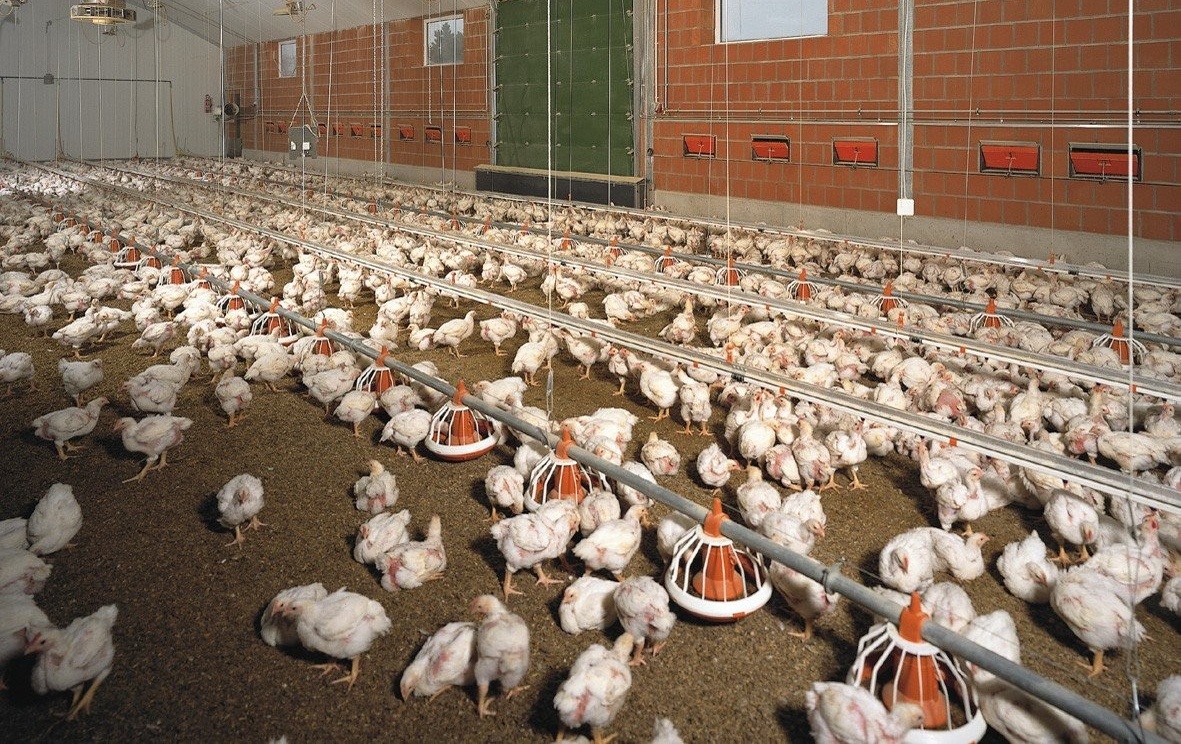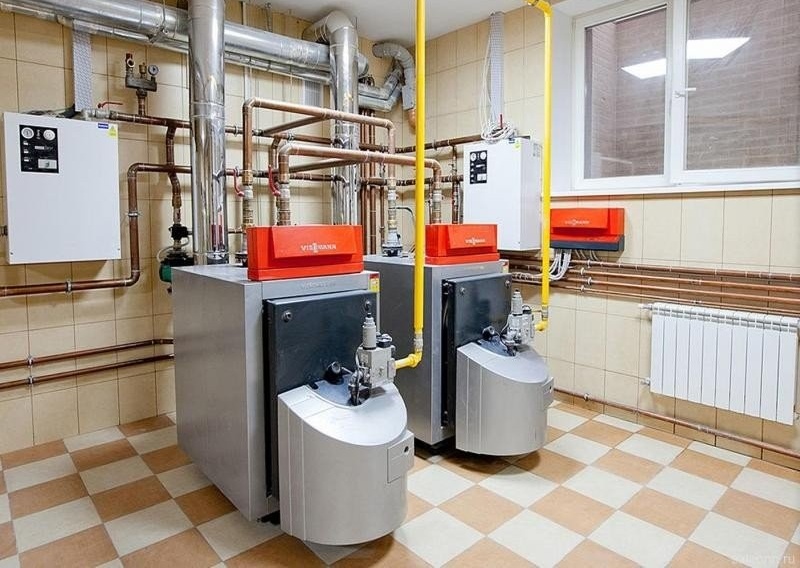How to install a ventilation system in a private house with your own hands
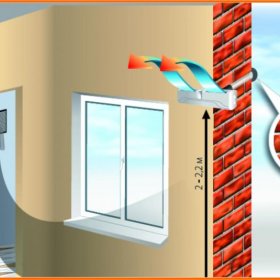
To create a comfortable microclimate in the premises of the house is possible only with appropriate ventilation. Stagnant air can cause mold on the walls, as well as physical ailment. An open window or window can not always qualitatively renew the air in the premises of a private house. To do this effectively, you need to install the supply and exhaust ventilation system.
Content
The principle of operation and the need for supply and exhaust ventilation in a private house
This type of ventilation is also called "forced". Unlike the natural circulation option, it is equipped with electrical appliances that pump and propel air currents.
Designs with a forced air exchange system are equipped with fans of various capacities, electronics, silencers and heating elements. All these devices are designed to provide housing with environmentally friendly oxygen, creating internal comfort and a feeling of freshness.
Unlike natural ventilation, the supply and exhaust air exchange is effective under the following conditions:
- The minimum temperature difference indoors and outdoors, when rising warm air, can not create traction.
- With an air pressure difference between the upper and lower levels of the structure.
This type of ventilation must be used for residential premises or buildings with several rooms located at different levels, as well as in areas with a polluted atmosphere. The supply and exhaust ventilation method will not only change the air in the room, but also make it clean, thanks to special filters provided in the system.
The design can carry out not only conventional filtration through the foam layer, but also produce this process using a lamp with ultraviolet light.
The ventilation system must be provided not only during the construction of the house, but also during the construction of the bath. More about this in our article:https://aquatech.tomathouse.com/en/ventilyaciya/kak-sdelat-ventilyatsiyu-v-bane-3.html.
An important role in the supply and exhaust system is played by:
- engine power and fans;
- class of filter material;
- heating element size;
- material quality and type of ducts.
Fans
Forced movement of air masses is provided by fans. Simple models are equipped with three levels of blade speed:
- normal;
- low (used for "quiet" work at night or during the absence of the owners);
- high, (used to create powerful air currents).
Modern models of fans are manufactured with a large number of speeds, which meets the needs of any owner. Fans are modernized by automatic and electronic controllers. This makes it possible to program the device by setting the speed modes of rotation of the blades. Electrical equipment allows you to synchronize ventilation with the system of "smart home".
Since the operation of the ventilation system is designed for a continuously long period, the quality of the fans should be at the highest level.
Filters
Supply air masses must be cleaned with filters. Recuperators are equipped with filter layers that are capable of retaining particles of less than 0.5 microns. This parameter corresponds to the European standard. A filter with this capacity does not allow spores of fungi, plant pollen, dry soot and dust to enter the room.
The presence of this device is especially important for owners suffering from allergic diseases.
The design of ventilation ducts can be equipped with several filter barriers, mounting them in front of heat exchangers. However, such filters are designed to protect them from dirt bearing exhaust flows.
Recovery systems are equipped with electronic sensors, which, having fixed the maximum degree of pollution of the filters, are signaled by a sound or light indicator.
Heating elements
The supply and exhaust ventilation system requires the installation of heating elements, since heat exchangers lose their effectiveness if the external air temperature is below -10 ° C. To do this, an electric heating system for the incoming air is mounted on the supply channel.
Modern heating elements are programmed for a specific mode of operation. This makes it possible to control the temperature without outside interference. Typically, computerized heating elements are installed and synchronized with a smart home system.
The size, power, shape and design of the heating elements are selected in accordance with the parameters of the entire ventilation system and the desire of the owner.
When choosing the power of a heater, it is necessary to take into account its operation at an external low temperature and high humidity. Such conditions will contribute to the fact that condensate may appear on the parts of the heat exchanger, which subsequently turns into ice. There are two ways to solve this problem:
- Change the operation of the supply fan. It must be turned on every 20-30 minutes for 5-10 minutes. The heated air stream passing through the heat exchanger eliminates glaciation.
- Change the direction of movement of cold air flows. For this, the supply air masses are separated, directing their flows past the heat exchanger.
Air ducts
It is most convenient to install ventilation in a building under construction - in basements, attics or behind suspended panels. It should be noted that the installation of this system should be carried out in a dry and insulated room with a plus temperature.
The most convenient and popular ducts are flexible options in aluminum or plastic. Pipes are made with round, square or rectangular cross-section. This material has a reinforcing frame made of steel wire, and can also be covered with a thermal insulation layer based on mineral fibers, for example, mineral wool.
From our next article, you can learn more about arranging ventilation in a bathhouse:https://aquatech.tomathouse.com/en/ventilyaciya/kak-sdelat-ventilyatsiyu-v-bane-2.html.
Supply and exhaust ventilation with heat recovery
Such a system implies its operation in the cold months. So that the incoming air flows do not cause cold in the house, the system must be modernized with a heat exchange device - an air recuperator. The device transfers heat to the cold air at the time of disposal of the outgoing.
Humid air concentrated in the kitchen, bathroom or utility room is routed out through the air intakes. Before leaving the ducts, it is trapped in the heat exchanger, which takes part of the heat, giving it to the opposite (supply air movement of the air masses).
A good recovery option with partial moisture recovery is implemented in Naveka units, the Node5 series.
Systems equipped with recuperators have gained great popularity in Western Europe. Thanks to this equipment, the buildings built in these regions lose 5-10 times less heat than those built without these systems. Utilization of heated exhaust streams reduced heat generation costs by 65–68%. This made it possible to recoup such a system for a period of 4–5 years. Energy efficiency of houses that are equipped with this system has reduced the heating period.
The size and power of the supply and exhaust systems equipped with a recuperator depend on the area and location of the ventilated rooms.
Enterprising homeowners install natural and forced (with heat recovery) in their homes. This is necessary in case of malfunction or repair of mechanical air exchange. Natural ventilation is convenient to use in an unheated period.
When using two ventilation systems in your home, you must adhere to the rule - natural ventilation ducts must be tightly closed during forced ventilation.
If this is neglected, then the quality of air renewal with the help of a supply and exhaust system will significantly decrease.
In ventilation systems, the following types of recuperators are most often used:
- lamellar;
- rotary;
- with intermediate heat carrier;
- chamber;
- in the form of heat pipes.
Lamellar recuperators
In this device, warm and cold air flows from both sides of the plates. This contributes to the formation of condensation on them. In this regard, special structures for accumulated water are installed on such structures. Moisture collection chambers should be equipped with valves to prevent liquid from entering the channel. If water drops enter the system, ice may form. Therefore, for the normal operation of the device, a defrosting system is necessary.
The appearance of ice can be avoided by controlling the operation of the bypass valve, which controls the amount of air flow passing through the device.
Lamellar recuperators have established themselves as devices with high efficiency (up to 90%). This fact made them popular among owners of houses with several rooms and floors.
Rotary
The heat transfer in this device occurs through the removed and supply channels as a result of rotation of the rotor disks. Elements of this system are not protected from dirt and odors, so their particles can move from one air stream to another.
The recovery of warm air flows can be controlled by changing the speed of rotation of the rotor discs.
This device, unlike the previous one, is less prone to freezing, since the working elements are mobile in dynamics. The efficiency of these devices reaches 75–85%.
Intercooler recuperators
The heat carrier in this design of the recuperator is water or a water-glycol solution. The peculiarity of this type is that the heat exchangers in different channels are one in the exhaust, the other in the supply. Water moves through the tubes between the two heat exchangers. The design has a closed system. This eliminates the ingress of contaminants from the exhaust air into the supply stream.
Heat transfer is regulated by changing the speed of movement of moisture in the coolant.
Such devices do not provide moving elements, so their effectiveness is lower, which is 45-60%.
Chamber
Heat exchange in this design occurs as a result of a change in the direction of air flow. Chamber recuperators are devices, usually in the form of a rectangular parallelepiped, with a camera, which are divided into two parts by a shutter. In the process, it changes the direction of the air masses so that the temperature of the supply air rises from the warmed chamber body. The disadvantage of this recuperator is that dirty particles and odors can mix with the exhaust and supply air.
Heat pipes
Recuperators of this type have a sealed case, inside which a system of tubes filled with freon is installed. Under the influence of high temperature (in the process of removing air), the substance turns into steam. At the moment of passage of the supply mass along the tubes, the vapor collects in droplets, forming a liquid. The design of such recuperators eliminates the transmission of odors and dirt. Since the housing of this device does not have moving elements, it has low efficiency (45–65%).
Due to their high efficiency, rotary and lamellar types gained the most popularity. The designs of the recuperators can be modernized, for example, by installing two plate-type heat exchangers in series. The effectiveness of such ventilation is increasing.
PVU design
When designing a ventilation system, it is necessary to determine the type of this device, since not every owner can fit its power and the amount of energy expended. In this regard, if there is no need for forced ventilation, it is better to establish natural ventilation.
Each ventilation system has its own standard parameters for the volume of air passed in 1 hour:
- for the natural version, this rate is 1m³ / h;
- for forced - in the range from 3 to 5 m³ / h.
When a ventilation system is designed for large rooms, it is advisable to install forced ventilation.
The design and installation of ventilation systems is a technically complex process, which includes several stages:
- The first stage consists of drawing up drawings and collecting data on the layout of the premises. Based on the established information, the type of ventilation system is selected, and the power of the equipment is determined.
- At the second stage, the necessary calculations are made according to the volume of air exchange of each room in the house. This is a crucial moment of design, since incorrect calculations, in the future, will cause stagnant air, the appearance of mold and fungi and a feeling of stuffiness.
- The third stage is the calculation of cross sections for ducts. This is also an important point, since incorrect calculations will cause low efficiency of the entire system, despite the expensive equipment. Therefore, it is better to entrust the calculations to specialists than to do it yourself.For the correct calculation of the size of the ducts, they are guided by the basic rules:
- in a natural hood, the air flow rate should correspond to 1 m / s;
- in air ducts equipped with fans, this parameter is 5 m / s;
- in the branches of the air ducts, the air mass velocity is 3 m / s.
- At the fourth stage, a diagram of the ventilation system with the indication of the separation valves is compiled. The purpose of this step is to correctly distribute the barriers preventing the spread of smoke and fire in case of fire.
- The fifth stage consists in coordinating the selected system with applicable regulatory documents and installation and placement rules. The finished project of the ventilation system must be approved by the fire, sanitary-hygienic and architectural organization. Obtaining permits from all these services and state bodies gives the right to installation.
Pay attention to the material on the design and installation of ventilation in the cellar of a private house:https://aquatech.tomathouse.com/en/ventilyaciya/kak-sdelat-ventilyatsiyu-v-pogrebe.html.
Calculations
During the calculations of the supply and exhaust ventilation systems, it is necessary to take into account the amount of replaced air in the room for a certain time. The unit is cubic meter per hour (m³ / h).
To apply this indicator to the calculations, it is necessary to calculate the passage of air flows and add 20% (the resistance of the filter layers and gratings).
Air volume calculation
As an example, the air volume for a private house with a ceiling height of 2.5 m was calculated. The system will also serve 3 bedrooms (11 m² each), an entrance hall (15 m²), a toilet (7 m²) and a kitchen (9 m²). We substitute the values (3 ∙ 11 + 15 + 7 + 9) ∙ 2.5 = 160 m³.
When making calculations, it is necessary to round up the data obtained upwards.
The installed recuperator must correspond to the power of all fans in the supply and exhaust system. To do this, it is necessary to subtract 25% of the total fan performance (air flow resistance in the system). The input and output of the recuperator must be equipped with fans.
It should be noted that in each room of the house where the system is located, 1 supply and 1 exhaust fan must be installed. The required performance of each of them is calculated as follows:
- Bedroom: 11 ∙ 2.5 = 27.5 + 20% = 33 m³ / h. Since the house has three bedrooms with the same area, it is necessary to multiply this value by three: 33 ∙ 3 = 99 m³ / h.
- Entrance: 15 ∙ 2.5 = 37.5 + 20% = 45 m³ / h.
- Toilet: 7 ∙ 2.5 = 17.5 + 20% = 21 m³ / h.
- Kitchen: 9 ∙ 2.5 = 22.5 + 20% = 27 m³ / h.
Now you need to add these values to get the total fan performance: 99 + 45 + 21 + 27 = 192 m³ / h.
The load on the recuperator will be: 192–25% = 144 m³ / h.
Calculation of the diameter of the ventilation duct
To calculate the diameter of the ventilation duct, it is necessary to use the formula for calculating the cross-sectional area, which is as follows: F = L / (S ∙ 3600), where L is the total number of air masses passing in one hour, S is the average air velocity equal to 1 m / s We substitute the values: 192 / (1 m / s ∙ 3600) = 0.0533 m².
To calculate the radius of a pipe with a round cross-section, you need to use the following formula: R = √ (F: π), where R is the radius of the round pipe; F is the cross section of the duct; π is a mathematical value equal to 3.14. For example, it looks like this: √ (0.0533 ∙ 3.14) = 0.167 m².
Electricity calculation
Properly calculated energy consumption will allow rational use of the ventilation system. This is especially important if the design of the ducts is equipped with heating elements.
To calculate the amount of energy consumed, you should use the formula: M = (T1 ∙ L ∙ C ∙ D ∙ 16 + T2 ∙ L ∙ C ∙ N ∙ 8) ∙ AD: 1000, where M is the total price for the electricity used; T1 and T2 - temperature difference in the day and night period (values have differences depending on the month of the year); D, N - the cost of electricity in accordance with the time of day; A, D - the total number of calendar days in a month.
Air temperature readings can be easily found from local weather forecasts, so there is no need to purchase any reference books. Tariffs are determined in accordance with the region of residence. Using these sources, you can get accurate readings on energy consumption during the operation of the ventilation system.
Equipment installation procedure
Installation of equipment elements of the supply and exhaust ventilation system of the premises is carried out after the walls are finished, before the installation of the suspended ceiling panels. The ventilation system equipment is installed in a certain order:
- The intake valve is mounted first.
- After it is a filter for cleaning the incoming air.
- Then an electric heater.
- Heat exchanger - recuperator.
- Duct cooling system.
- If necessary, the system is equipped with a humidifier and a fan in the supply duct.
- If ventilation high power, a noise isolating device is installed.
Do-it-yourself ventilation system installation
Installation of a ventilation system consists of several building steps:
- Using the previously obtained values, calculate the optimal parameters for the holes in the wall.
- Make markup to place the supply channel. To drill a hole in a concrete wall, it is necessary to use the installation with a construction drill for concrete surfaces. This device is fixed to the wall, so that the hole is smooth, in a precisely marked location. The contact point of the core drill and the concrete wall is insulated with a special cap, to which pipes with a stream of water and a powerful vacuum cleaner are connected.
- After making a hole, lay the duct pipe in it.
- From the outside, it must be covered with a net to prevent debris and insects. Install a small canopy on top of the net.
- Under the ceiling, make markings for installing the exhaust duct. Please note that this duct must be located in the wall opposite the supply duct. The exhaust pipe must be at least 50 cm above the roof.
- Equip the supply duct with fans.
Duct installation
Installation of air ducts should be preceded by drawing up diagrams and drawings. And you should take care of the presence of additional fasteners and clamps. Installation of air ducts is carried out in the following order:
- Prepare tools (electric drill, construction level, hacksaw, pencil).
- Using a pencil and a ruler, mark the required length of the air channel. Cut the pipe with a hacksaw into elements of the required size.
- If metal ducts are used, then the welded or welded method is used to connect them. To do this, you need to prepare clamps, a welding machine or a construction gun. Plastic air ducts have shaped elements, so they are easily connected without requiring additional sealing.
- Every 100–150 cm, a special suspension must be attached to the duct and ceiling. These structural parts will hold all the pipes, preventing them from swaying or disconnecting.
How to operate and maintain PVU
The quality work of the supply and exhaust ventilation system depends not only on the professional installation, but also competent service. Elements of a supply and exhaust device require:
- periodic cleaning of filters;
- their updating, in case of pollution or the expiration of the term of operation;
- replacement of lubricant for moving parts and fan parts;
- if the system is equipped with heating elements, ionizers and insulators from noise, a regular check of their serviceability is necessary.
Usually, all the necessary steps to care for this system are described in the operating instructions and instructions.
Video: ventilation of the apartment in 2 levels with heat recovery
Having familiarized yourself with all the nuances of the installation and equipment of the ventilation system, you can make a healthy and comfortable atmosphere in your home, providing yourself and loved ones with fresh air.
